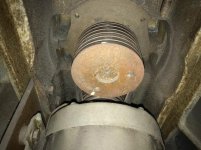Okay a couple small issues. #1 When the head feeds back away from me it doesn't always change direction when I flip the lever. It has also stopped half way across my part. I flip the lever up and then back down and it goes again. It doesn't seem like the lever is popping out of feed. Its still down all the way when the feed stops. What could be causing this?
#2 It has a permanent magnet chuck. I'm not sure when the last time this thing was used. The lever was fairly stiff when I went to use it. It seems no matter what way I flip the lever. The magnet doesn't disengage. I have a heck of a time getting my parts off of it. I don't know how they work inside. Is it possible that there is rust inside and when I flip the lever the magnet doesn't release?
#3 I bought this grinder to mainly do one job. I make these tools from M2 64Rc that are about 2" wide and 5" long. I finish grind them after heat treat. I thought I could take .001" per pass. One forward and one back. It seems to be really bogging the wheel down. I ended up going .0005" per pass but now it takes twice as long. I put 4 tools on the chuck at once with space between them. Also the tools aren't solid. They have holes in them and a cut out. The wheel is a 7"x 1/2" Radiac 8BP46-G800-VOS ceramic wheel. I run coolant to keep it cool. I figured either my wheel is wrong or the grinder just doesn't have to power to do what I'm asking it to do. My breaker is 20 amp and it tripped after about 15 mins of grinding. Guess I'll need to upgrade that too. Any thoughts here? Should I try a different wheel? Or am I pushing it too hard?
#2 It has a permanent magnet chuck. I'm not sure when the last time this thing was used. The lever was fairly stiff when I went to use it. It seems no matter what way I flip the lever. The magnet doesn't disengage. I have a heck of a time getting my parts off of it. I don't know how they work inside. Is it possible that there is rust inside and when I flip the lever the magnet doesn't release?
#3 I bought this grinder to mainly do one job. I make these tools from M2 64Rc that are about 2" wide and 5" long. I finish grind them after heat treat. I thought I could take .001" per pass. One forward and one back. It seems to be really bogging the wheel down. I ended up going .0005" per pass but now it takes twice as long. I put 4 tools on the chuck at once with space between them. Also the tools aren't solid. They have holes in them and a cut out. The wheel is a 7"x 1/2" Radiac 8BP46-G800-VOS ceramic wheel. I run coolant to keep it cool. I figured either my wheel is wrong or the grinder just doesn't have to power to do what I'm asking it to do. My breaker is 20 amp and it tripped after about 15 mins of grinding. Guess I'll need to upgrade that too. Any thoughts here? Should I try a different wheel? Or am I pushing it too hard?



